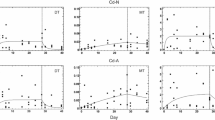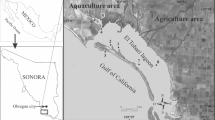Abstract
Flux of the heavy metal cadmium through the euphausiid Meganyctiphanes norvegica was examined. Radiotracer experiments showed that cadmium can be accumulated either directly from water or through the food chain. When comparing equilibrium cadmium concentration factors based on stable element measurements with those obtained from radiotracer experiments, it is evident that exchange between cadmium in the water and that in euphausiid tissue is a relatively slow process, indicating that, in the long term, ingestion of cadmium will probably be the more important route for the accumulation of this metal. Approximately 10% of cadmium ingested by euphausiids was incorporated into internal tissues when the food source was radioactive Artemia. After 1 month cadmium, accumulated directly from water, was found to be most concentrated in the viscera with lesser amounts in eyes, exoskeleton and muscle, respectively. Use of a simple model, based on the assumption that cadmium taken in by the organism must equal cadmium released plus that accumulated in tissue, allowed assessment of the relative importance of various metabolic parameters in controlling the cadmium flux through euphausiids. Fecal pellets, due to their relatively high rate of production and high cadmium content, accounted for 84% of the total cadmium flux through M. norvegica. Comparisons of stable cadmium concentrations in natural euphausiid food and the organism's resultant fecal pellets indicate that the cadmium concentration in ingested material was increased nearly 5-fold during its passage through the euphausiid. From comparisons of all routes by which cadmium can be released from M. norvegica to the water column, it is concluded that fecal pellet deposition represents the principal mechanism effecting the downward vertical transport of cadmium by this species.
Similar content being viewed by others
Literature Cited
Anonymous: Baseline studies of pollutants in the marine environment and research recommendations, IDOE Baseline Conference, May 24–26, 1972, New York 1972
Boothe, P.N. and G.A. Knauer: The possible importance of fecal material in the biological amplification of trace and heavy metals. Limnol. Oceanogr. 17, 270–274 (1972)
Bowen, V.T., J.S. Olsen, C.L. Osterberg and J. Ravera: Ecological interactions of marine radioactivity. In: Radioactivity in the marine environment, pp 200–222 Washington, D.C.: National Academy of Sciences 1971
Butterworth, J., P. Lester and G. Nickless: Distribution of heavy metals in the Severn estuary. Mar. Pollut. Bull. 3, 72–74 (1972)
Calabrese, A., R.S. Collier, D.A. Nelson and J.R. MacInnes: The toxicity of heavy metals to embryos of the American oyster Crassostrea virginica. Mar. Biol. 18, 162–166 (1973)
Casanova, B.: Les euphausiacés de Méditerranée (Systématique et développement larvaire. Biogéographie et biologie). Thèse de Docteur es-Sciences Naturelles, Université de Provence, Aix-Marseille 1, 380 pp. 1974
Eisler, R.: Cadmium poisoning in Fundulus heteroclitus (Pisces: Cyprinodontidae) and other marine organisms. J. Fish. Res. Bd Can. 28, 1225–1234 (1971)
Fowler, S.W. and G. Benayoun: Experimental studies on cadmium flux through marine biota. In: Comparative studies of food and environmental contamination, pp 159–178, Vienna: IAEA 1974
—— and L.F. Small: Experimental studies on feeding, growth and assimilation in a Mediterranean euphausiid. Thalassia jugosl. 7, 35–47 (1971a)
— and L.F. Small: Sinking rates of euphausiid fecal pellets. Limnol. Oceanogr. 17, 293–296 (1972)
—— and S. Kečkeŝ: Effects of temperature and size on molting of euphausiid crustaceans. Mar. Biol. 11, 45–51 (1971b)
Goldberg, E.D., W.S. Broeker, M.G. Gross and K.K. Turekian: Marine chemistry. In Radioactivity in the marine environment, pp 137–146. Washington, D.C.: National Academy of Sciences 1971
Huynh-Nog, L.: L'application de l'électrode indicatrice “graphite-mercure” en redissolution anodique par voltamétrie pour la détermination simultanée du Zn, Cd, Pb et du Cu dans l'environment aquatique. Thèse de doctorat d'Université de Nice, 124 pp. 1973
Kobayashi, J.: Relation between the “Itai-Itai” disease and the pollution of river water by cadmium from a mine, 7 pp. Paper presented at the 5th International Water Pollution Research Conference, July 1970
Kuenzler, E.J.: Elimination of iodine, cobalt, iron and zinc by marine zooplankton. In: Symposium on radioecology, pp 462–473. Ed by D.J. Nelson and F.C. Evans. Oak Ridge: USAEC Technical Information Division 1969a
—: Elimination and transport of cobalt by marine zooplankton. In: Symposium on radioecology, pp 483–492. Ed. by D.J. Nelson and F.C. Evans. Oak Ridge: USAEC Technical Information Division 1969b
Leatherland, T.M., J.D. Burton, F. Culkin, M.J. McCartney and R.J. Morris: Concentrations of some trace metals in pelagic organisms and of mercury in Northeast Atlantic Ocean water. Deep-Sea Res. 20, 679–685 (1973)
Lowman, F.G., T.R. Rice and F.A. Richard: Accumulation and redistribution of radionuclides by marine organisms. In: Radioactivity in the marine environment, pp 161–199. Washington, D.C.: National Academy of Sciences 1971
Martin, J.H. and G.A. Knauer: The elemental composition of plankton. Geochim. cosmochim. Acta 37, 1639–1653 (1973)
Mauchline, J. and L.R. Fisher: The biology of euphausiids. Adv. mar. Biol. 7, 1–454 (1969)
Nickless, G., R. Stenner and N. Terrille: Distribution of cadmium, lead and zinc in the Bristol Channel. Mar. Pollut. Bull. 3, 188–190 (1972)
O'Hara, J.: The influence of temperature and salinity on the toxicity of cadmium to the fiddler crab, Uca pugilator. Fish. Bull. U.S. 71 149–153 (1973)
Peden, J.D., J.H. Crothers, C.E. Waterfall and J. Beasley: Heavy metals in Somerset organisms Mar. Pollut. Bull. 4, 7–10 (1973)
Pentreath, R.J.: The accumulation from water of 65Zn, 54Mn, 58Co and 59Fe by the mussel, Mytilus edulis. J. mar. biol. Ass. U.K. 53, 127–143 (1973)
Preston, A., D.F. Jefferies, J.W.R. Dutton, B.R. Harvey and A.K. Steele: British Isles coastal waters: the concentrations of selected heavy metals in sea water, suspended matter and biological indicators — a pilot survey. Envir. Pollut. 3, 69–82 (1972)
Small, L.F. and S.W. Fowler: Turnover and vertical transport of zinc by the euphausiid Meganyctiphanes norvegica in the Ligurian Sea. Mar. Biol. 18, 284–290 (1973)
—— and S. Kečkeŝ: Flux of zinc through a macroplanktonic crustacean. In: Radioactive contamination of the marine environment, pp 437–452. Vienna: IAEA 1973
Topping, G.: Heavy metals in zooplankton from Scottish waters, North Sea and the Atlantic Ocean. In: Baseline studies of pollutants in the marine environment, pp 149–158. Background papers for a workshop sponsored by the National Science Foundation's IDOE, Brookhaven National Laboratory, 24–26 May, 1972
Windom, H.L.: Arsenic, cadmium, copper, lead, mercury and zinc in marine biota-North Atlantic Ocean. In: Baseline studies of pollutants in the marine environment, pp 121–147. Background papers for a workshop sponsored by the National Science Foundation's IDOE, Brookhaven National Laboratory, 24–26 May, 1972
— and R.G. Smith: Distribution of cadmium, cobalt, nickel and zinc in southeastern United States continental shelf waters. Deep-Sea Res. 19, 727–730 (1972)
Author information
Authors and Affiliations
Additional information
Communicated by J.M. Pérès, Marseille
Rights and permissions
About this article
Cite this article
Benayoun, G., Fowler, S.W. & Oregioni, B. Flux of cadmium through euphausiids. Marine Biology 27, 205–212 (1974). https://doi.org/10.1007/BF00391945
Accepted:
Issue Date:
DOI: https://doi.org/10.1007/BF00391945




